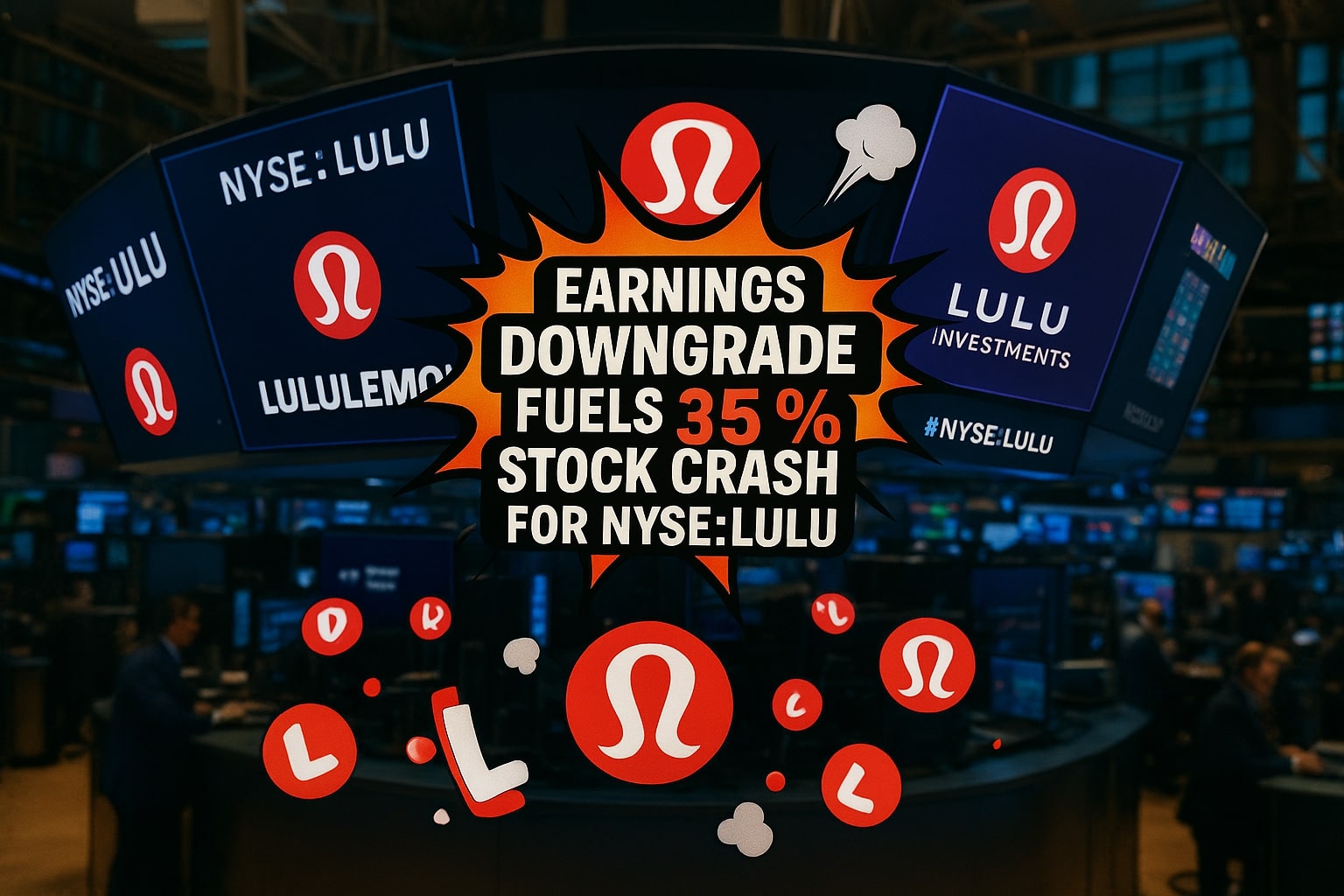
Lululemon (NYSE:LULU) Struggles with U.S. Slowdown as Global Expansion Anchors Valuation
Margin Pressure, Tariffs, and Weak U.S. Comps Force a Reset on LULU Stock Outlook | That's TradingNEWS
Revenue Slowdown Hits Core U.S. Market for NYSE:LULU
LULU posted $2.37 billion in revenue for Q1 FY2025, rising 7% year-over-year, but the internal geography breakdown exposed deep regional issues. While China surged +22% on a constant-currency basis, and international revenue outside the U.S. advanced +17%, the company’s largest and most mature geography—the Americas—saw comparable sales fall -1%, marking a significant deterioration from the prior quarter’s flatline. On a constant currency basis, U.S. comps have now declined into negative territory for the first time in years.
This stagnation underscores the vulnerability of Lululemon’s brand equity in its most saturated market. Consumers in the U.S. are rotating toward rivals like Vuori and Alo, driven by the natural fashion fatigue that comes with a high-exposure brand lacking in deep luxury heritage. Even with its once-dominant position in women’s athleisure, LULU is now confronting an identity crisis at home, evidenced by six months of lagging growth in same-store metrics.
Earnings Downgrade Fuels 35% Stock Crash for NYSE:LULU
Earnings per share guidance for FY2025 has been slashed to a range of $14.58–$14.78, down from the prior midpoint of $15.05. That adjustment, though seemingly minor at face value, reflects a deeper deterioration in cost structure and pricing flexibility. Tariffs alone are set to cut into gross margins by 110 basis points, a steep increase from the prior expected impact of 60 bps.
This revision triggered a violent market repricing. From pre-earnings levels near $270, LULU stock fell below $235, wiping out over $6 billion in market cap, and pushing the stock’s EV/EBIT multiple to a 10-year low. Despite the strong balance sheet with $1.33 billion in cash and no debt, the P/E ratio, ex-cash, now trades near 15.3x, slightly below S&P 500 averages. Investors are pricing in margin erosion and long-term saturation, not a temporary stumble.
Margin Compression Reflects Strategic Weakness in NYSE:LULU
Gross margin in Q1 expanded +60 basis points to 58.3%, but the victory is hollow. Operating margin dropped -110 basis points to 18.5%, driven by overhead costs, product development investment, FX impact, and the deeper tariff bite. Q2 is projected to see an even sharper decline—gross margin expected to drop by 200 basis points versus Q2 2024—due to markdowns, depreciation, and higher occupancy expenses.
These trends are not cyclical noise—they reflect strategic fragility. Management’s goal of maintaining a premium brand image is being directly undermined by increased reliance on inventory markdowns. “Summer Scores,” LULU’s recent product line, is being discounted by as much as 35%, placing it in the pricing territory of mass-market players. The damage is twofold: compressed margins and brand dilution. Once customers learn to expect discounts, full-price elasticity is permanently impaired.
Core Product Pricing Power Persists—but Narrowly—for NYSE:LULU
The only real insulation LULU still enjoys is in a narrow subset of flagship items. Women’s leggings and men’s dress pants remain full-price, with no signs of slowing demand. This suggests that the brand still retains a sticky core base—but the success is not being replicated across new categories.
While these products hold pricing power, they alone cannot drive top-line growth, especially when new lines like Daydrift and Summer Scores are underperforming. Unlike Aritzia, which saw +33% YoY revenue growth and +19% comps, LULU’s spring/summer launches have not resonated.
International Growth Becomes the Lifeline for NYSE:LULU
The clear standout in the quarter was international expansion. Mainland China revenue surged +22%, and the rest of world posted +17% CC growth. Management expects China to deliver 25%–30% full-year growth, with international segments forecast to rise around 20%. These markets remain underpenetrated and receptive to the Lululemon brand, unlike the increasingly saturated U.S. base.
However, even this momentum is slowing. Chinese comparable store sales grew +8%, a sharp deceleration from +27% in Q4. Management blamed the earlier Chinese New Year timing, which shifted spending into Q4, but the slowdown remains stark.
This international push has come at a cost. Store count expansion is accelerating in China and Europe, but without the same comp leverage. Many of these stores are growing revenue from a zero base, rather than improving unit economics across the board. This raises questions about future profitability as the store footprint balloons in geographies where fashion cycles are even more fluid.
Capital Efficiency Remains World-Class at NYSE:LULU
Despite all headwinds, LULU continues to deliver extremely high returns on invested capital (ROIC). Chart data confirms operating leverage remains intact, and even under compressing margins, the company generates shareholder value through disciplined reinvestment.
The balance sheet holds $1.33 billion in cash, with no long-term debt. That financial flexibility will allow the company to withstand several quarters of weak performance without existential threat. However, the stock’s former premium was predicated on consistent execution—not survival.
A conservative DCF model built around 7%–5%–2.5% annual profit growth bands and a 12.5% discount rate values the stock at roughly 30% above current trading levels. Even with assumptions designed to stress-test worst-case outcomes, NYSE:LULU appears materially undervalued from an intrinsic standpoint.
Innovation Strategy: Attempting to Reset the Narrative for NYSE:LULU
Lululemon has responded to the slowdown with new product pushes—Daydrift, Shake It Out, BeCalm for women, and Zeroed In, Smooth Spacer, ShowZero for men. Management also launched a no-seam version of its flagship legging and introduced new running shorts targeting ultra-athletes. But market traction is uneven.
CEO Calvin McDonald emphasized five categories for future expansion: yoga, run, train, golf, and tennis. Yet none of the Q1 data show these innovations delivering meaningful sales reacceleration. Without evidence of adoption, it’s unclear whether this strategy is a brand evolution or a reactive shuffle.
The company’s long-term vision to be the top global destination for performance wear across these categories sounds ambitious. But product cycle testing takes time, and current comps offer little reassurance that Lululemon is driving fashion momentum rather than chasing it.
BUY, SELL, OR HOLD VERDICT FOR NYSE:LULU
Verdict: HOLD – Undervalued, but No Immediate Catalyst
NYSE:LULU is trading near historic valuation troughs, with EV/EBIT at a 10-year low and an ex-cash P/E of 15.3x, yet it still delivers 58.3% gross margins and world-class ROIC. That disconnect strongly suggests the stock is undervalued on a long-term DCF basis. Even using conservative assumptions, the intrinsic value appears 30% higher than the current price.
However, key problems remain unresolved. U.S. sales are declining, the brand is facing markdown-driven margin erosion, and international comps are losing steam, especially in China. The innovation pipeline hasn’t demonstrated breakout success, and EPS guidance has already been slashed due to tariff and cost pressure.
There’s no visible catalyst in the short term to re-rate the stock higher. While LULU will likely not fall much further, a sharp rebound requires either a turnaround in U.S. comps, meaningful product traction, or a surprise earnings beat—none of which are guaranteed this year.
Buyers should wait. Sellers may have already missed the ideal exit. Long-term holders should stay patient, as valuation supports recovery—but only once execution improves. LULU remains a HOLD, with directional risk tilted to mild upside if international momentum stabilizes.
That's TradingNEWS
Read More
-
GDX ETF at $88 While Gold Tests $4,400: Are Gold Miners Poised for $100?
19.12.2025 · TradingNEWS ArchiveStocks
-
XRP ETF Boom: XRPI at $10.94 and XRPR at $15.49 as XRP-USD Clings to the $1.80–$1.90 Zone
19.12.2025 · TradingNEWS ArchiveCrypto
-
Natural Gas Price Forecast: NG=F Hovering Near $3.92 As Weather, LNG And Storage Collide
19.12.2025 · TradingNEWS ArchiveCommodities
-
USD/JPY Price Forecast - Dollar to Yen Near 157 as BoJ’s 0.75% Rate Hike Backfires on the Yen
19.12.2025 · TradingNEWS ArchiveForex


















